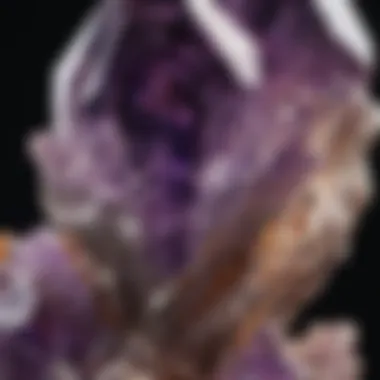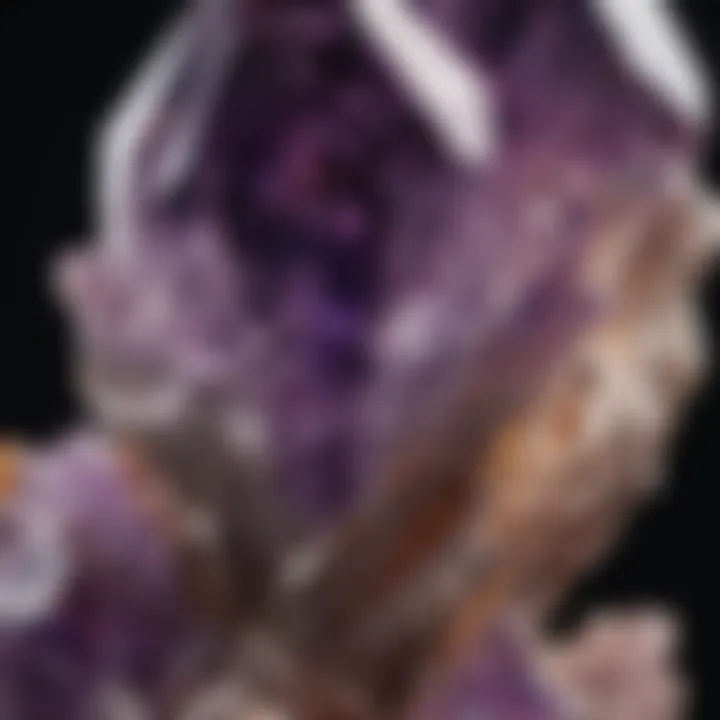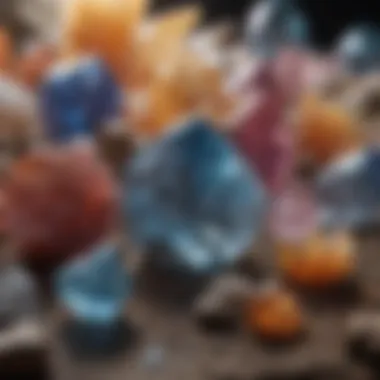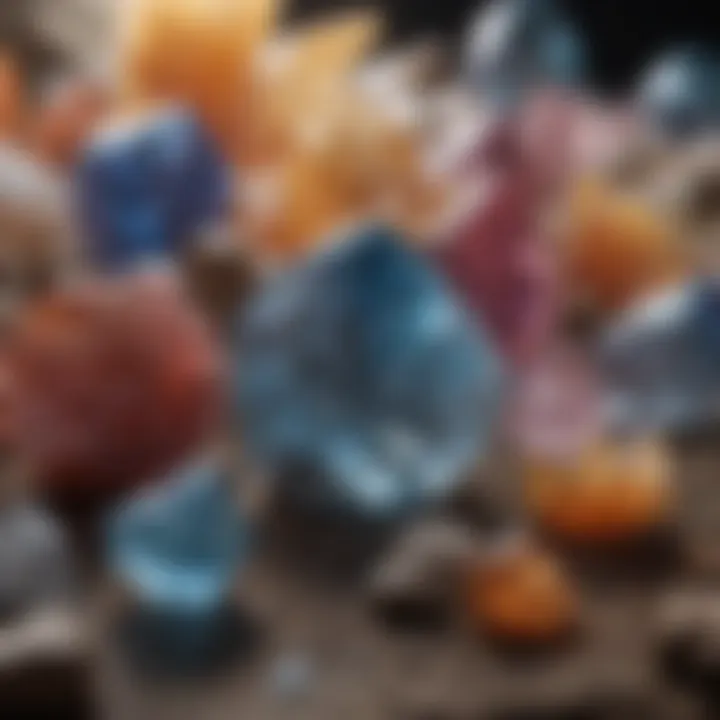Explore the Intriguing World of Crystals


Intro
Crystals captivate many due to their beauty and unique properties. This guide aims to unravel the complex world of crystals, presenting both popular and obscure varieties. We explore their origins, classifications, and applications, offering rich insights for collectors and enthusiasts alike. The following sections will provide a structured approach to understanding these geological wonders, ensuring readers gain a deeper appreciation for their significance.
History and Origins
Understanding the history of crystals provides context for their current relevance. Crystals have been utilized for thousands of years, serving as not only decorative items but also tools for spiritual practices. Ancient civilizations, such as the Egyptians and Greeks, revered specific minerals, associating them with various powers and attributes. For example, lapis lazuli was much valued for its deep blue color and was often used in jewelry and ritual objects.
Overview of Collectibles, Rocks, and Fossils
The study of crystals is intertwined with that of rocks and fossils. Crystals form within geological environments, and their identification is essential for collectors. Collecting has become a popular hobby, highlighting the beauty and diversity found in natural specimens. Many enthusiasts focus on specific types of crystals, developing unique collections that reflect their interests.
Historical Significance and Cultural Impact
Throughout history, crystals have impacted cultures globally. For instance, quartz is often associated with healing properties and used in alternative medicine. Ancient texts document their use in rituals and as adornments, emphasizing their spiritual dimensions. Different cultures have held various beliefs about the energies embodied in these minerals.
Identification and Classification
Identifying and classifying crystals is crucial for collectors seeking to understand their specimens better. Each crystal possesses specific characteristics that can aid in identification. Color, clarity, and crystal structure are among the factors considered in their classification.
Guide to Identifying Rocks and Fossils
Identifying rocks and fossils can present unique challenges. Beginners may use a few guidelines to assist with this process:
- Color: Observe the color of the specimen. Certain colors are often associated with specific minerals.
- Hardness: Use the Mohs scale to determine the hardness of the crystal. This can help narrow down the options when identifying.
- Luster: Pay attention to how a crystal reflects light.
Common Types and Variations
There are numerous crystal varieties, each with its own set of variables. Some of the most well-known types include:
- Quartz: Common and versatile, found in many different forms.
- Amethyst: A purple variant of quartz, valued for its beauty.
- Citrine: Recognized for its yellow hue, often used in jewelry.
- Fluorite: Known for its vibrant colors, pleasing to the eye.
These classifications and types contribute to their value and desirability among collectors.
Knowing the history and classifications of crystals enriches any collection.
In subsequent sections, we will delve deeper into each type, providing insights on their unique attributes and practical applications.
Prologue to Crystals
Crystals have fascinated humanity for centuries, capturing the imagination of both scientists and enthusiasts alike. Understanding crystals is essential as they not only form the basis for various minerals and elements but also hold significant cultural, historical, and metaphysical values. As this article explores different aspects of crystals, it emphasizes their unique properties and the varied contexts in which they are found.
One crucial element in studying crystals is their classification. Recognizing the differences among various types, whether they are mineral, organic, or synthetic, enables collectors and researchers to appreciate their occurrence and use better. Moreover, understanding crystals can lead to informed decisions about acquisition, care, and display. The benefits of knowing different varieties also include an enriched experience when visiting mineral shows or interacting with other collectors.
In this section, we will cover key components that help in comprehending what crystals are and the science behind their properties.
Understanding Crystals
Crystals are solid materials where atoms are arranged in orderly patterns. This orderly arrangement sets them apart from amorphous solids, like glass, which do not have a defined structure. One of the primary characteristics of crystals is their formation process, which happens through crystallization. Crystals can crystallize from various situations, such as cooling molten rock or evaporating solutions.
Many factors influence the formation and growth of crystals. These include:
- Temperature: Affects how fast crystals can grow. Higher temperatures often lead to more rapid growth, while lower temperatures allow for larger crystals to form over time.
- Pressure: Changes the way crystals form. Some minerals crystallize better under significant pressure compared to others.
- Chemical environment: The composition of the solution or melt can determine the types of crystals that form. Different minerals yield varying types of crystals.
Each of these factors plays an integral role in creating the diverse range of crystals found in the natural world.
The Science Behind Crystals
The scientific study of crystals involves multiple disciplines, including chemistry, geology, and physics. In chemistry, the arrangement and interaction of atoms within crystals provide insight into bonding and molecular behavior. The lattice structure present in crystalline materials leads to unique physical properties such as hardness, light transmission, and electrical conductance.
In geology, crystals are essential in understanding the Earth's processes. They can indicate the conditions under which a rock formed, such as temperature and composition. By studying crystal formations, geologists can infer the history of geological events.
Crystallography is a specialized field focusing on the study of crystal structures. It explores:
- Symmetry: Crystals exhibit various symmetrical properties, influencing their classification.
- X-ray diffraction: A common method to analyze crystal structures. When X-rays hit crystals, they diffract, providing information about their arrangement.
- Mineral identification: The unique properties of crystals aid in identifying and classifying minerals.
Understanding these scientific elements enhances our grasp of how crystals fit into our world, confirming their significance beyond mere aesthetics.
"Crystals are not just objects of beauty; they also serve as a gateway to understanding the physical world around us."


This segment establishes the foundation for deeper topics concerning crystal varieties, helping collectors appreciate their complexities and significance.
Classification of Crystals
The classification of crystals plays a pivotal role in understanding their characteristics and applications. Knowing how to categorize crystals aids in exploration, identification, and appreciation. Each type of crystal offers unique properties, which can be beneficial depending on the context in which they will be used. Understanding this classification is essential for collectors, enthusiasts, and professionals alike. It shapes the way we interact with these natural wonders.
Mineral Crystals
Mineral crystals are the most prominent category within the classification of crystals. They originate from natural geological processes, forming as the Earth’s elements are fused together. Common examples include quartz, feldspar, and mica. These crystals can occur in numerous environments, from volcanic formations to sedimentary deposits.
The significance of mineral crystals extends to a variety of fields, including geology and material sciences. They are often studied for clues to the Earth’s history and evolution. Their physical properties—such as hardness, transparency, and color—also play a critical role in their classification. For collectors, specific mineral crystals represent a connection to the geological processes that formed them.
- Hardness: Measured by the Mohs scale, identifying the hardness can indicate the mineral type.
- Color: Variation in color may signify different impurities or defects in the structure.
- Crystal Habit: The characteristic shapes that crystals take as they grow provide insight into their environment.
Organic Crystals
Organic crystals consist of materials derived from living organisms. Examples include certain carbon-based crystals, like amber and jet, which originate from organic matter. Their classification as organic crystals highlights the relationship between life and geology.
The study of organic crystals is vital to paleo-biology and geology. They can provide information about ancient environments and life forms, which enriches our understanding of Earth’s biological history. For collectors, organic crystals often carry a sense of history and can be perceived as more relatable than mineral crystals, as they stem from the biological process.
While their beauty is apparent, organic crystals also have specific care requirements. Exposure to light, for instance, can cause fading. Collectors should consider factors affecting the preservation of these materials.
Synthetic Crystals
Synthetic crystals are man-made and created through various chemical processes. These include products like cubic zirconia and synthetic emeralds. They mimic natural crystals’ properties but often with enhanced clarity and color saturation.
The importance of synthetic crystals lies in their applications across industries, from jewelry to electronics.
- Purposeful Design: They can be engineered for specific qualities that may not be possible in nature.
- Affordability: Synthetic variants often offer a cost-effective alternative to natural stones.
- Ethical Considerations: The creation of synthetic crystals lessens the impact of mining, addressing some environmental concerns.
While they lack the natural nuances found in organic and mineral crystals, synthetic alternatives appeal to a broad audience due to their accessibility and versatility.
Common Crystals
Common crystals, such as Quartz and Amethyst, play a vital role in both the collection and utilization of gemstones. Their properties and wide availability make them highly sought after and significant for various applications. This section will explore the notable qualities of these crystals, detailing their benefits, and considerations when they are used in personal collections or practical remedies.
Quartz
Variants of Quartz
Quartz exists in multiple variants, including Rose Quartz, Smoky Quartz, and Citrine. These different forms of Quartz each have distinct optical and chemical characteristics. For instance, Rose Quartz is known for its soft pink hue, often associated with love and tranquility. Such variants allow collectors to delve into unique aesthetics while also providing various uses. The key characteristic of these variants is their versatility, making them a popular choice for both decorative and metaphysical purposes. Each variant, however, can have its advantages and disadvantages; for example, while Rose Quartz is widely available and affordable, its softness can lead to scratches or damage more easily compared to more robust variants like Smoky Quartz.
Uses and Benefits
The uses and benefits of Quartz extend into numerous fields, including technology, healing, and artistry. Notably, Quartz is utilized in making high-precision clocks and devices due to its piezoelectric properties. This application makes it an essential mineral in modern technology. Its unique feature lies in its ability to store and transmit energy, which is often linked to many healing practices. Because Quartz can help amplify energy, it is a beneficial inclusion for those pursuing crystal healing. However, one must consider the environment where Quartz is used, as it can absorb energy from negative sources.
Amethyst
Properties and Effects
Amethyst is esteemed for its beautiful violet color and powerful metaphysical properties. This crystal is known to promote calm and alleviate stress, making it a highly sought-after stone for those interested in emotional and mental well-being. The key characteristic that sets Amethyst apart is its ability to enhance intuition and spiritual awareness. This make it a valuable resource for practitioners of meditation and spiritual growth. Nevertheless, one should be cautious with overexposure to sunlight, as the color of Amethyst can fade with prolonged exposure.
Care and Maintenance
Proper care and maintenance of Amethyst are crucial for preserving its vibrant color and energy. Regularly cleaning the crystal is essential to remove any accumulated negative energy. Unique features of Amethyst care include avoiding harsh chemicals and opting for gentle cleansing methods, such as water or mild soap. Routine maintenance enhances both the appearance and effectiveness of this crystal, solidifying its position as a valuable asset to any collection. Users should take care to store Amethyst in a cool, dark place to prevent any fading.
"Common crystals, like Quartz and Amethyst, are not merely beautiful specimens but also serve significant roles in various practical applications"
In summary, common crystals are not only accessible but also integral to both everyday life and specialized practices. Understanding their distinct characteristics and uses allows collectors to appreciate them on a deeper level.
Rare Crystals
Rare crystals hold a special place in the world of mineralogy and collecting. Their scarcity often adds to their allure and value. When discussing rare crystals, it is essential to consider their geological origins and unique features. Collectors seek them not only for personal enjoyment but also as investments. Understanding what makes a crystal rare provides insight into its significance in both nature and human culture.
Benitoite
Occurrence and Value
Benitoite is a striking blue barium titanium silicate mineral, found primarily in California. The rarity of this crystal stems from its limited geographical occurrence. It is mainly sourced from a small area in the San Benito River region, which lends it a unique charm. The stunning blue color enhances its attraction, making it highly sought after by collectors, geologists, and jewelers alike.


Benitoite is considered one of California's state gems. Its value can easily reach thousands of dollars per carat, depending on size and quality. The key characteristic of its occurrence and value lies in its geography and historical significance. Collectors appreciate knowing the precise location where their crystals originate, which adds to their narrative. This unique geographical aspect amplifies its desirability, as many other beautiful crystals are more widely available.
Advantages: Uncommon find, historical relevance, and high market value.
Disadvantages: Limited source area, not easy to find on the market.
Significance in Collecting
The significance of benitoite in the collecting community cannot be understated. This crystal ranks high among collectors who prioritize uniqueness and historical context. Its beauty, combined with its rarity, has established it as a prized item.
Additionally, benitoite often sparks discussion about conservation efforts regarding its natural habitat. Collectors interested in ethical sourcing may value it not just for its beauty but also for its environmental implications.
Overall, benitoite's limited availability and compelling backstory make it a standout choice for crystal collectors.
Red Beryl
Identification Tips
Red beryl, often called bixbite, is one of the rarest gems in the world. Its identification is crucial for both collectors and investors. This mineral has a deep red color, which can mislead those unfamiliar with its properties. Its vibrant hue occurs due to manganese content, but distinguishing it from similar-looking stones can be challenging.
Key identifiers include its unique crystal structure, which typically forms in hexagonal shapes. To differentiate red beryl from other stones, collectors should look for its specific refractive index and hardness level. Using a gem tester can greatly assist in identifying genuine red beryl.
Advantages: High value when identified correctly, unique characteristics.
Disadvantages: Easily confused with other red gemstones, requires knowledge for accurate identification.
Market Demand
The market demand for red beryl remains consistently high due to its extreme rarity. Unlike more common gemstones, the availability of red beryl is limited, which drives up its price. Collectors and jewelers often keenly seek it out, resulting in steady interest in the stone.
The key characteristic of this market demand lies in its exclusivity. Few people own or can afford red beryl, making it an attractive asset for collectors looking to own rare gems. High demand also leads to increasing prices, assuring potential buyers see it as a sound investment.
Advantages: High investment potential, exclusivity attractiveness.
Disadvantages: Risk of counterfeit stones in the market.
In summary, rare crystals such as benitoite and red beryl not only hold aesthetic and monetary value but also provide insight into geology, ethics, and community dynamics in collecting.
Uses of Crystals
Understanding the various uses of crystals is crucial for enthusiasts and collectors alike. Beyond their appeal as beautiful natural elements, crystals serve multiple practical purposes in several fields and cultural practices. Here, we will explore the significant applications of crystals in both industrial and metaphysical contexts, highlighting their importance.
Industrial Applications
Crystals are not merely ornamental; they hold essential roles in various industries. The properties of different crystals make them suitable for specific applications.
- Electronics: Quartz crystals, for instance, are integral in electronic devices. They are used in oscillators to regulate frequency in radios, watches, and computers.
- Optics: Crystals like calcite and fluorite are valued in optical applications due to their light-refracting abilities. They are utilized in prisms, lenses, and even lasers.
- Construction Materials: Some minerals, such as gypsum, are widely used in building materials. Their structural integrity and aesthetic qualities contribute to construction and decoration.
The industrial applications of crystals emphasize their functional significance. Harvesting these natural resources responsibly is vital to sustain their availability for future innovations.
Metaphysical Properties
The metaphysical properties of crystals are a vast realm where many enthusiasts find connection and meaning. Each crystal is believed to possess unique energies and can influence various aspects of life.
- Healing: Many people utilize crystals for their purported healing properties. For instance, amethyst is commonly associated with stress relief and clarity of mind.
- Meditation: Practitioners often use crystals during meditation to enhance focus and create a tranquil environment. Stones like lapis lazuli or selenite can promote a deeper meditative state.
- Energy Work: Crystals are often incorporated into practices like Reiki and chakra balancing. Practitioners believe they can facilitate energy flow and balance the body's energy centers.
"Understanding the metaphysical properties of crystals can deepen one's appreciation and connection to these natural wonders."
People interested in these aspects should approach the topic with an open mind and a willingness to explore various traditions and practices.
Caring for Crystals
Caring for crystals is essential for both enthusiasts and collectors. Proper care enhances a crystal's durability, aesthetic appeal, and metaphysical properties. Regular maintenance ensures that crystals are not only visually stunning but also energetically potent. Different types of crystals have unique care requirements, making it vital to be informed about specific methods.
Understanding the significance of caring for your crystals can deepen your connection to them. Well-maintained crystals can bring their full benefits, whether in a collection, as an everyday accessory, or for spiritual work. Neglecting to care for them may lead to diminished vibrancy or damage, ultimately affecting their value and effectiveness.
Cleaning Methods
Cleaning your crystals is crucial in maintaining their energy and appearance. The cleaning methods vary depending on the type of crystal, its properties, and its uses. Here are some recommended cleaning techniques:
- Running Water: For most crystals, gently rinsing under lukewarm water can remove dirt and stagnant energy. Not all crystals tolerate water well; for instance, selenite should never be submerged.
- Salt Water: Some collectors use salt water for crystals that are less porous. However, prolonged exposure to salt can cause damage, so it’s wise to use this sparingly.
- Smudging: Use natural herbs like sage or palo santo to smudge your crystals. The smoke is believed to clear negative energy and restore balance.
- Sound Cleansing: Singing bowls or tuning forks can create vibrations that help cleanse crystals energetically. This method can be particularly effective for larger specimens or clusters.
- Earth Burial: Some practitioners bury their crystals in the earth for a period. This is thought to help reset their energy. Always remember to mark where you buried them to retrieve them later.
"Caring for your crystals nurtures not just their physical properties but also their spiritual essence."
Storage Solutions


Storing your crystals properly is as important as cleaning them. Poor storage can lead to scratches, chips, and energy confusion. Here are some effective storage solutions:
- Soft Cloth Pouches: Use pouches made from natural fabrics to prevent scratches and keep dust off. Choose different pouches for various types of crystals.
- Display Cases: For collectors, glass display cases protect and showcase crystals. Ensure they are in a stable environment away from direct sunlight, extreme temperatures, or humidity.
- Dividers: If utilizing a drawer, consider using dividers. This allows crystals to be separated, reducing the chance that they will scratch against each other.
- Labels: If you have many pieces, labeling your crystals can help in identification. This is particularly necessary for those who use crystals in healing practices.
- Avoid Stacking: Avoid stacking crystals directly on top of one another. When stacked, heavier stones can create pressure and lead to breaks or chips.
By incorporating these care techniques into your routine, you can enhance the life and beauty of your crystals. Proper cleaning and storage are key to preserving their integrity, both physically and energetically.
Identifying Crystals
Identifying crystals is an essential skill for collectors, enthusiasts, and individuals interested in the geological or metaphysical properties of crystals. Knowing how to accurately identify crystals not only enhances your collecting experience but also ensures you appreciate their distinct characteristics. This process involves analyzing various physical attributes and employing specific testing techniques to distinguish one crystal from another, especially given the vast number of varieties and their sometimes overlapping features. Effective identification can lead to informed purchasing decisions and a greater understanding of the crystals' potential uses and benefits.
Visual Characteristics
The visual characteristics of crystals are often the primary way to start identification. Several aspects are critical in this regard:
- Color: The hue of a crystal can hint at its identity. For example, amethyst is recognized for its distinct purple color, whereas citrine is known for yellow.
- Luster: A crystal's shine can vary significantly, from glassy to matte. Quartz generally has a glassy luster, while others like malachite have a silky or earthy sheen.
- Transparency: Determining whether a crystal is transparent, translucent, or opaque is useful. Clear quartz is a prime example of a transparent crystal, while obsidian is opaque.
- Crystal Form: The physical shape, or habit of a crystal, can also provide clues. For instance, pyrite commonly forms in cubic crystals, whereas calcite may form in rhombohedral shapes.
- Inclusions: Sometimes, crystals have air bubbles or minerals trapped within them. Such inclusions can either detract from their value or increase it, depending on the context.
"Understanding the visual characteristics of crystals is crucial for both identification and valuation."
These visual identifiers work together to form a unique profile of each crystal, aiding in sorting and classification.
Testing Techniques
While visual inspection is a great starting point, several testing techniques can assist in the accurate identification of crystals:
- Hardness Test: Using the Mohs hardness scale, you can scratch the surface of a crystal with known minerals. For example, if it scratches glass, it is likely harder than 5.5.
- Acid Test: Some crystals, like calcite, will fizz when in contact with hydrochloric acid, indicating their presence. However, caution is needed due to safety concerns with handling acids.
- Density Tests: By measuring a crystal's weight compared to its size, one can deduce its density, which can help in identification. For example, specific gravity can help differentiate between quartz and some heavier gem-quality minerals.
Certain tools, such as a hand lens or gem tester devices, can enhance the identification process. Using these aids allows for a more detailed examination of the crystal's specific features, providing greater confidence in the identification conclusion.
Employing these visual characteristics and testing techniques ensures collectors can identify and appreciate their crystals more effectively.
Connecting with the Crystal Community
Connecting with the crystal community provides an essential platform for collectors and enthusiasts alike. This collective space fosters knowledge exchange and enhances the appreciation of crystals. Understanding diverse perspectives and experiences is vital to deepening one's engagement with this intricate field. The crystal community serves not only as a support network but also as a resource for sharing valuable information related to collecting, identifying, and caring for crystals.
Engagement with fellow enthusiasts can lead to various benefits. First, sharing experiences allows individuals to learn from others' journeys, including tips on sourcing authentic crystals and avoiding potential pitfalls. In addition, participating in community activities opens doors to exclusive events, such as gem and mineral shows, where one can meet like-minded individuals. Collectors will also find that collaboration often leads to more substantial exchanges, improving the overall quality of their collection.
Resource exchange is another significant aspect of this community. Members often share insights on the latest research or developments in the field. This includes information on how certain crystals can be used in metaphysical practices, or the historical significance of an emerging specimen. Staying informed is crucial for any serious collector, and the community is a great place for that.
Joining Collectors' Groups
Joinings collectors' groups can be highly beneficial for both novice and experienced collectors. Local and national groups, such as those found on platforms like Facebook, serve as hubs for sharing knowledge and experiences. Members often discuss their findings and techniques, providing insights that are not easily available through articles or websites.
Moreover, these groups occasionally organize meetups and events. These gatherings allow members to showcase their collections, trade specimens, or simply discuss personal interests in crystals. Such interactions often drive deeper connections among collectors.
It's essential to find a group that aligns with your focus and values. Some groups might specialize in specific types of crystals or collecting methods, while others offer a broader scope. Consider exploring options like:
- Local rock and mineral clubs
- Specialty collector groups focused on particular crystal types
- Online communities on Facebook and Instagram
By participating actively in a collectors' group, you can expand your knowledge base while also contributing your unique experiences to others.
Participating in Online Forums
Online forums provide an alternative avenue for engagement with the crystal community. Websites like Reddit host communities dedicated to various aspects of crystal collecting. Engaging in these forums allows you to exchange ideas, ask questions, and share your findings in a low-pressure environment.
In these forums, topics can range from cleaning techniques to the latest trends in crystal collections. Members take pride in mutual learning, and odds are your inquiry will attract valuable responses. Furthermore, sharing your discoveries or experiences can make a lasting impression and help establish your presence within the community.
When navigating online forums, keep these considerations in mind:
- Read the forum rules and guidelines to understand acceptable behaviors.
- Remain open to differing opinions while participating in discussions.
- Offer assistance or advice when possible, as this fosters relationships.
Participating in these online spaces not only broadens your understanding but also connects you with fellow enthusiasts worldwide. Together, members of these forums create an enriching environment for all who share a passion for crystals.
The End
The conclusion serves as a vital component in understanding the broader implications of crystals within various contexts. It brings together the insights shared throughout the article, highlighting the multifaceted roles that crystals play in both natural and man-made environments. Their significance stretches beyond aesthetic appeal, anchoring deep in their scientific properties, metaphysical beliefs, and industrial applications.
Summarizing the Significance of Crystals
Crystals are not merely decorative items but are valuable resources of knowledge and exploration. Here are some key points to consider:
- Diversity and Classification: From mineral crystals like quartz to organic ones such as amber, the diversity in crystals is immense. Understanding their classifications helps collectors and enthusiasts appreciate their unique traits.
- Applications: Crystals find their way into numerous fields. For instance, industries rely on crystals for their physical properties, while metaphysical practitioners view them as tools for healing and energy work.
- Historical and Cultural Relevance: Crystals hold significance in many cultures, often regarded as symbols of power or spiritual guidance. This cultural backdrop enhances their appeal to collectors.
- Community Engagement: Connecting with other collectors and enthusiasts fosters a shared passion. Through forums and collectors' groups, individuals can exchange insights, valued tips, and further their knowledge about crystal care and identification.
In essence, crystals encapsulate a blend of geological marvel and human curiosity. They provide an extraordinary glimpse into Earth’s history and the wonders of nature, all while encouraging a community of enthusiasts seeking deeper understanding.
"Crystals are nature's work of art, conveying stories etched in time and matter."
Understanding crystals extends beyond collecting; it nurtures a deeper appreciation for the Earth’s treasures, prompting us to explore their roles in various aspects of life.



